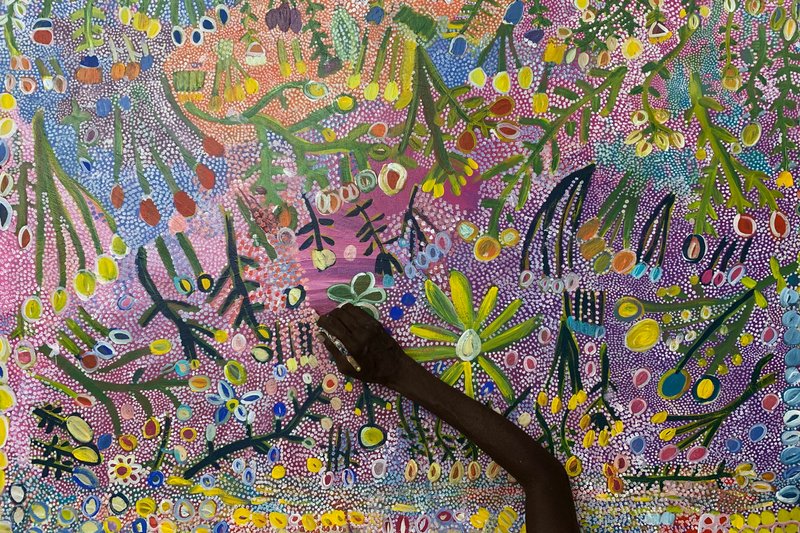Why and how to add your voice to National Cultural Policy
It is up to us to ensure that the whole of the visual arts ecology is heard and that our needs are well represented in arts policy.
It is up to us to ensure that the whole of the visual arts ecology is heard and that our needs are well represented in arts policy.

Image: Gwenneth Blitner at work (untitled work), acrylic on linen 2021. Image courtesy of Ngukurr Arts. © Gwenneth Blitner/Copyright Agency, 2022.
We currently have a momentous opportunity to influence policy change and improve the fundamental conditions of work and practice in the arts. This cultural policy will be Australia’s first in a decade. Let’s ensure the voices and needs of the visual arts, craft and design sector are both loud and highly visible in the national conversation about the future of arts and culture. NAVA urges everyone to make a submission before the 22 August deadline.
The Federal Government’s National Cultural Policy consultation is a promising gesture. Unlike other recent consultations and inquiries, which often ask for evidence that demonstrates the value of the arts, or the impact of the pandemic and budget decisions on our lives, this consultation is simply asking for what we need moving forward.
Submissions are due on 22 August 2022. So soon. NAVA has received advice that the government is looking for ‘neat’ recommendations to include in their new National Cultural Policy. The word ‘neat’ suggests they are looking to copy and paste good recommendations straight into the policy.
While there is a lot of interest in short term goals that the government can achieve in two to three years, they are also welcoming long term ideas. NAVA has joined a consortium of national peak arts organisations who are calling for a commitment from the government that the policy will guide a more comprehensive development of a ten-year National Cultural Plan to harness those long term goals.
It is up to us to ensure that the whole of the visual arts ecology is well represented and that our needs are heard. To help, NAVA recently hosted five workshops centred on each of the five pillars outlined by the government’s new policy framework. These meetings were a chance for our Members and subscribers to brainstorm, collaborate, and share ideas for arts policy.
We have pages and pages of notes from each of the five workshops full of brilliant and achievable ideas to strengthen the sustainability of the sector for artists as workers and creators of culture. Each set of notes starts with a list of the key recommendations which came out of each session, followed by summaries of the group discussions presented by workshop participants.
NAVA encourages artists, arts workers, organisations and networks, audiences and friends to scroll through these notes and support as many of the recommendations as you like in your own submission to the government consultation.
What would you like to see in arts policy? An industrial award rate for the visual arts and craft? Legislation on the payment of artists’ fees and superannuation contributions? Support for First Nations-led education, training, employment and representation in leadership roles and middle-tier jobs?
There is a template for writing submissions on the government’s consultation website, alongside a recommendation for submissions to be no longer than three pages. This is a guide, designed to be helpful, but it is not essential that you use the template or stick to the three page suggestion. You may write as much or as little as you like and in whatever format you like.
Where possible, try to align your ideas or recommendations with one or more of the five pillars of the government’s consultation framework. NAVA has received confirmation that the consultation will accept non-written submissions in alternative formats, and they can be emailed through to culturalpolicy@arts.gov.au. They have suggested a limit of 3 pages or 5 minutes for submissions.
Minister for the Arts, the Hon Tony Burke MP, has been clear in his announcements that he recognises the dire situation that the arts is in and therefore aims to launch the policy before the end of this year. With such a tight turnaround we can assume that what is received will be read through rather quickly. Those tasked with reading submissions and feeding recommendations up to the Minister’s office will be looking for consistent patterns, ideas and recommendations that are frequently called for in submissions.